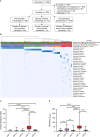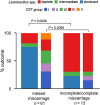The association between vaginal bacterial composition and miscarriage: a nested case-control study
- PMID: 31573753
- PMCID: PMC6972675
- DOI: 10.1111/1471-0528.15972
The association between vaginal bacterial composition and miscarriage: a nested case-control study
Abstract
Objective: To characterise vaginal bacterial composition in early pregnancy and investigate its relationship with first and second trimester miscarriages.
Design: Nested case-control study.
Setting: Queen Charlotte's and Chelsea Hospital, Imperial College Healthcare NHS Trust, London.
Population: 161 pregnancies: 64 resulting in first trimester miscarriage, 14 in second trimester miscarriage and 83 term pregnancies.
Methods: Prospective profiling and comparison of vaginal bacteria composition using 16S rRNA gene-based metataxonomics from 5 weeks' gestation in pregnancies ending in miscarriage or uncomplicated term deliveries matched for age, gestation and body mass index.
Main outcome measures: Relative vaginal bacteria abundance, diversity and richness. Pregnancy outcomes defined as first or second trimester miscarriage, or uncomplicated term delivery.
Results: First trimester miscarriage associated with reduced prevalence of Lactobacillus spp.-dominated vaginal microbiota classified using hierarchical clustering analysis (65.6 versus 87.7%; P = 0.005), higher alpha diversity (mean Inverse Simpson Index 2.5 [95% confidence interval 1.8-3.0] versus 1.5 [1.3-1.7], P = 0.003) and higher richness 25.1 (18.5-31.7) versus 16.7 (13.4-20), P = 0.017), compared with viable pregnancies. This was independent of vaginal bleeding and observable before first trimester miscarriage diagnosis (P = 0.015). Incomplete/complete miscarriage associated with higher proportions of Lactobacillus spp.-depleted communities compared with missed miscarriage. Early pregnancy vaginal bacterial stability was similar between miscarriage and term pregnancies.
Conclusions: These findings associate the bacterial component of vaginal microbiota with first trimester miscarriage and indicate suboptimal community composition is established in early pregnancy. While further studies are required to elucidate the mechanism, vaginal bacterial composition may represent a modifiable risk factor for first trimester miscarriage.
Tweetable abstract: Vaginal bacterial composition in first trimester miscarriage is associated with reduced Lactobacillus spp. abundance and is independent of vaginal bleeding.
Keywords: First trimester miscarriage; second trimester miscarriage; vaginal bacteria; vaginal microbiome.
© 2019 The Authors. BJOG: An International Journal of Obstetrics and Gynaecology published by John Wiley & Sons Ltd on behalf of Royal College of Obstetricians and Gynaecologists.
Figures



References
-
- Simpson JL, Mills JL, Kim H, Holmes LB, Lee J, Metzger B, et al. Infectious processes: an infrequent cause of first trimester spontaneous abortions. Hum Reprod (Oxford, England) 1996;11:668–72. - PubMed
-
- Simpson JL, Gray RH, Queenan JT, Barbato M, Perez A, Mena P, et al. Further evidence that infection is an infrequent cause of first trimester spontaneous abortion. Hum Reprod (Oxford, England) 1996;11:2058–60. - PubMed
-
- Allanson B, Jennings B, Jacques A, Charles AK, Keil AD, Dickinson JE. Infection and fetal loss in the mid‐second trimester of pregnancy. Aust N Z J Obstet Gynaecol 2010;50:221–5. - PubMed
Publication types
MeSH terms
Substances
Grants and funding
- P62774/Tommy's National Centre for Miscarriage Research/International
- P45272/UK National Institute for Health Research Biomedical Research Centre/International
- March of Dimes European Preterm Birth Research Centre at Imperial College London/International
- NIHR CLAHRC NWL (Collaboration for Leadership in Applied Health Research & Care, North-West London)/International
- MR/L009226/1/MRC_/Medical Research Council/United Kingdom
LinkOut - more resources
Full Text Sources
Other Literature Sources
Medical
Miscellaneous

